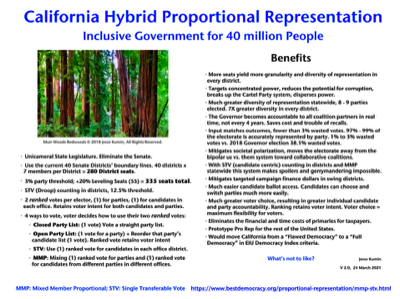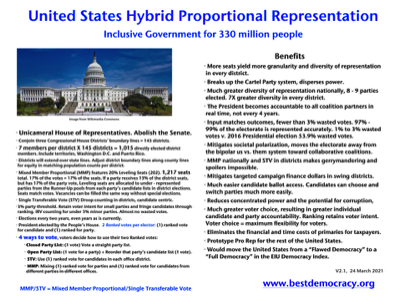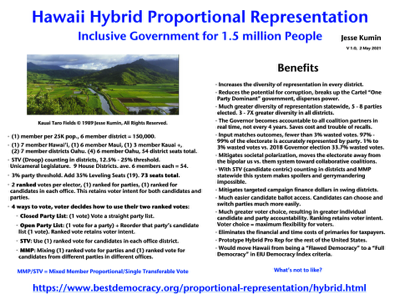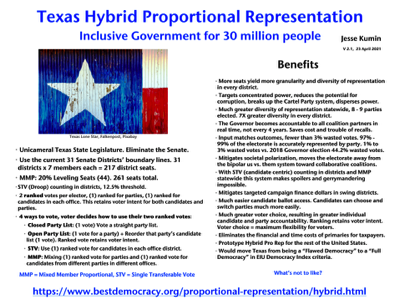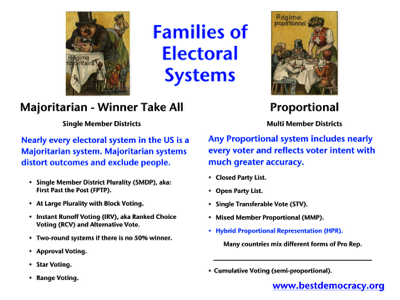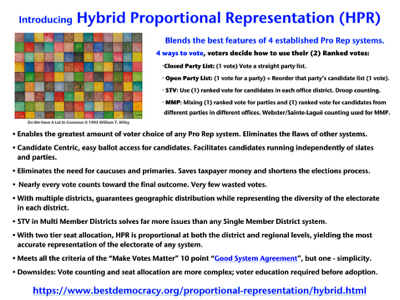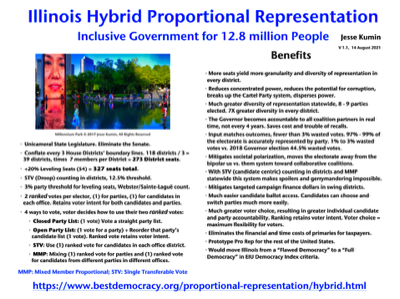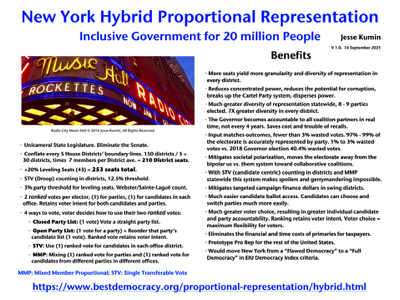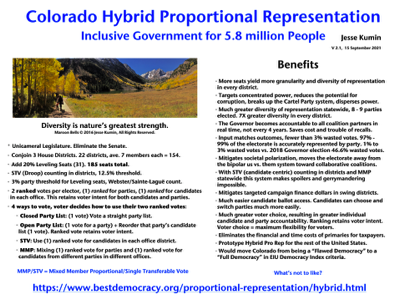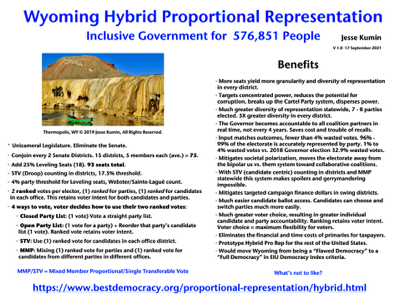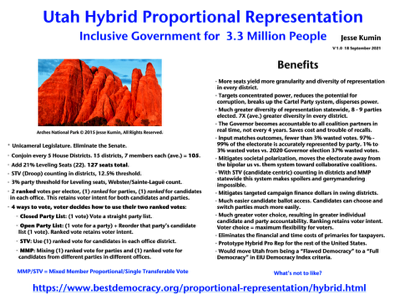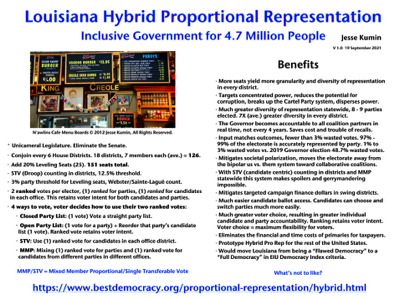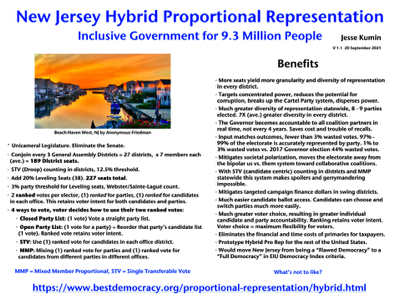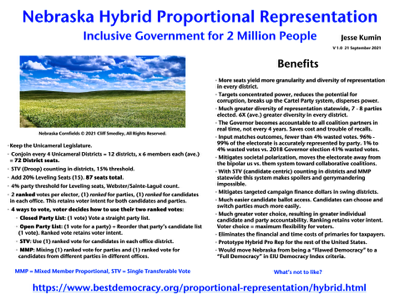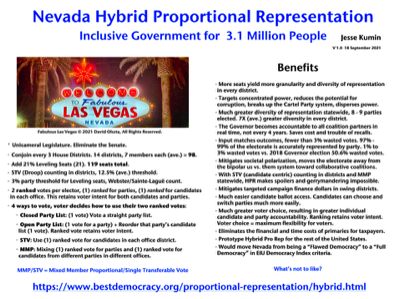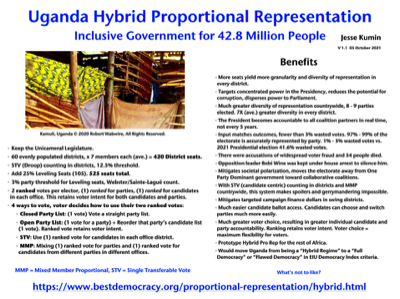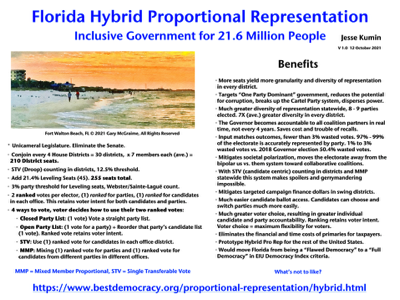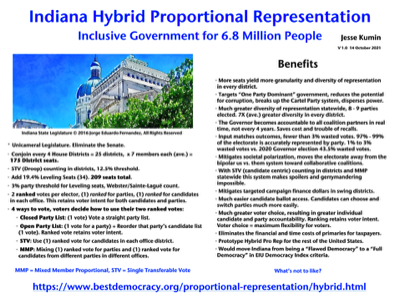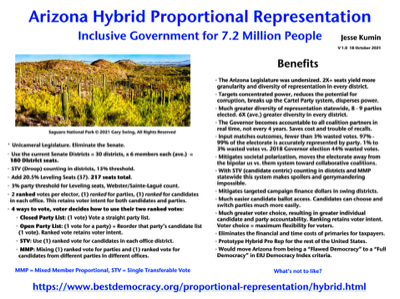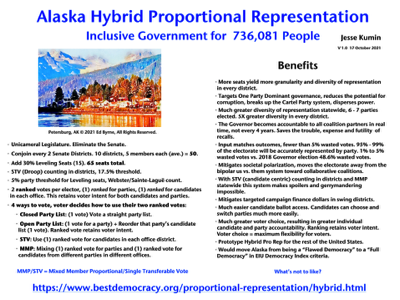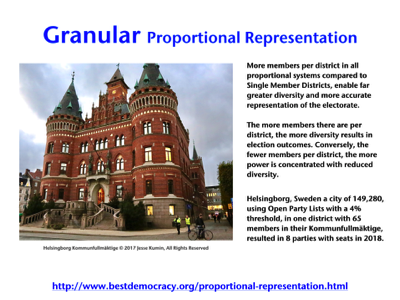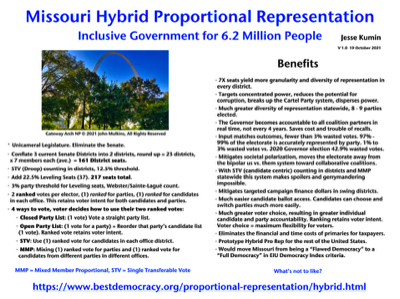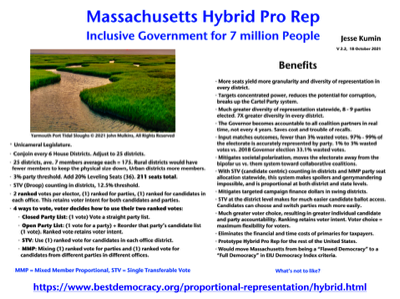Whenever we look at maps of the political landscape in the United States, they are always depicted in red and blue, symbolizing the two headed Cartel Party system that controls the US. Two color maps are made possible by Single Member Districts.
I'm dreaming of a Proportional Map made up of lots of colors, more like a William T. Wiley painting, made possible by Multi Member Districts. Perhaps 2021 is the year we break out of limited palette, two color, bipolar thinking, see and embrace the world for all the diversity we have.
Well implemented Proportional Representation systems fairly and accurately represent 95% - 98% of the electorate. Combining features from Mixed Member Proportional (MMP) with leveling seats for accuracy, a two tier counting system, Single Transferable Vote (STV), Closed and Open Party Lists, removes all the distortions in First Past the Post, Single Member District elections, removes obstacles to party and candidate ballot access, disperses power, eliminates a host of other issues and puts voters in the driver's seat. Hybrid Pro Rep cherry picks best features from existing Pro Rep systems in New Zealand, Sweden, Denmark, Australia and Germany. Each voter has their choice of how they want to vote.
Imagine combining an additional member Mixed Member Proportional (MMP) system (mix party and candidates) with an Open Party List system. Add in Single Transferable Vote counting in districts and the option of voting a straight, Closed Party List. Each elector casts two votes instead of one. On a double ballot, the elector chooses a party of choice and also his or her favorite candidate among those listed. Voters can mix their party and candidate choices.
Hybrid Proportional Representation (HPR) offers the greatest diversity of voter choice of how each voter votes, easy candidate and party ballot access of Single Transferable Vote, across a full spectrum of ideological viewpoints, offering voters a full spectrum of choice, producing nuanced, diverse outcomes representing everyone. HPR enables voters to both reward and punish individual candidates and parties, vastly increasing accountability. HPR mitigates choke holds party bosses can exert on candidates in "Closed List" systems. With multiple parties fielding candidates, candidates also have more choice and much greater ballot access. If an office holder doesn't like the direction of a party, or their position on a party list, that individual can more easily move to another party. It is advantageous for parties to recruit a variety of well qualified candidates for voters to pick from, at least as many candidates as seats in a district.
Hybrid Pro Rep is designed to facilitate voter choice, party and candidate ballot access, and yield accurate outcomes. With a 3% party threshold and ranking, at least 97% and as high as 99% of voters will have their vote go to exactly the party they voted for. With average 7 member districts, at least 82.5% will elect candidates they want elected to district offices.
With two ranked votes, one for Parties, the other for Candidates in Multi Member Districts, Hybrid Pro Rep is fully proportional, MMP at the regional level and STV in districts. It's actually all four Pro Rep systems in one; voters determine how they want their votes to count. Each voter can use either one or both of their two votes and taylor a Pro Rep system to fit their needs.
1) Closed Party List: Use one Party vote only for a party. Each party determines it's own list order. If the party is marginally popular and may not make the 3% cut, rank your Party vote with additional choices, so your intent isn't lost.
2) Open Party List: (1) Use your one Party vote for a party and (2) use your Candidate vote to reorder that same party's list order, ranking their individual candidates in the district election by your own preference.
3) Single Transferable Vote (STV): Use only your Candidate vote at the district level in 7 member districts, Droop STV counting. Candidates can choose to affiliate with a party (to their advantage at the MMP stage) or run as unaffiliated.
4) Mixed Member Proportional (MMP): Mix parties and candidates. (1) Use your Party vote for a party, and (2) use your Candidate vote for ranking candidates from different parties for different offices.
Tabulation and Seat Allocation
• Candidate votes for different offices are tabulated by district.
• Party votes are tabulated regionally for Party seat allocation.
STV "Droop" quota counting allocates seats in district elections. Watch this excellent "What is STV? video that describes the process in 2 min. 12 sec.
In MMP, a pool of seats are not allocated in the first district level allocation, but allocated at the regional level to accurately fine tune district level results. These seats adjust aggregate percentages of party affiliated candidates elected in districts, to accurately reflect voter party intent at the regional level.
If a party's candidates received 17% of the district seats, but received 21% of the party votes, that party would receive an additional 4% of their seats from the Leveling pool to accurately fill their quota of seats. Leveling seats are filled from the best loser, runner up pool in district elections using the Webster/Sainte-Laguë counting method. Candidates from a party receiving Leveling seats are selected from the party's losing candidates who did fairly well, but didn't make the quota for a district seat.
"Flexible stems bend in the wind. Rigid ones snap." - Dennis Potter
If seats don’t match votes, Hybrid Pro Rep uses a tuning mechanism to improve accuracy. The number of party assigned Leveling seats can always be increased, say from 20% to 25%, so that party vote percentages match seat assignments. Germany applies this flexible approach of matching votes with seats in its implementation of MMP. The size of the Bundestag can change from election to election.
Vacancies from resignations, deaths, removal or other cause, can be filled the same way, from a party's runner up pool, without the cost and time of vacancy elections. This saves taxpayer money. Taxpayers also save money and time by not funding any parties' primary events as we do now. The Cartel parties use the aparatus of state election processes to fund their candidate selection. HPR would reverse the incentive to exclude candidates, replacing exclusions with an incentive to build the most inclusive, high quality candidate lists. Each party's candidate list development process would be self funded and self determined.
The HPR system is based on 5 - 7 member districts. The number of district members can vary based on geography. Rural districts with the same population matching urban district populations, can be quite large physically. Without reducing the number of constituents each seat represents, rural districts can be designed with fewer members to reduce geographical size. Urban districts tend to be more diverse. They can have more members, without increasing the number of constituents each seat represents. Diversity and accuracy lost in rural districts with fewer seats, can be made up in the second tier of seat allocation, the Leveling seats, at the regional level.
In Sweden, about 3/4ths of voters use their one vote to vote for a party and let the party order the list (Closed Party List). About 1/4th opt to choose individual candidates (Open Party List). Some folks may hate all the parties but like individual candidates in their district (STV). Other folks like myself, will want to choose a favorite party and individual candidates for different offices from different parties (MMP). This system accomodates all four types of voter.
Hybrid Pro Rep meets nearly every condition of the UK Make Votes Matter Good Systems Agreement. Vote counting and seat allocation are more complex than with Majoritarian systems, and results take longer to determine. Far better quality results on criteria like accuracy and retention of voter intent, inclusiveness of all demographic subsets of the electorate, and remarkably few wasted votes, outweigh the additional complexity of a two tier vote counting and seat allocation process.
Why not use any existing system from any of the 94 countries that use Proportional Representation?
No one system of Proportional Representation is perfect. Each Pro Rep system has issues. Hybrid Pro Rep (HPR) eliminates issues with earlier versions of Proportional Representation and eliminates nearly all wasted votes. Hybrid Pro Rep incorporates best features from the top five proportional electoral systems:
"According to a 2006 survey of electoral system experts, their preferred voting methods were, in order of preference:
• Mixed Member Proportional (MMP)
• Single Transferable Vote (STV)
• Open Party List (OPL)
• Instant Runoff Voting (IRV) (aka Ranked Choice and Alternative vote)
• Closed Party List (CPL)
I apologize for the alphabet soup of acronyms, but it's a lot shorter to write the acronymn than full names each use.
Issues with current systems
Mixed Member Proportional
The two most prominent users of Mixed Member Proportional (MMP), Germany and New Zealand, have both implemented MMP with First Past the Post (FPTP) in Single Member District (local) elections. MMP as implemented isn't proportional at the district level, otherwise, MMP is a superb system. MMP as proposed for Quebec is a vast improvement over their current FPTP, Single Member District system, but not as flexible or accurate as Hybrid Pro Rep.
Single Transferable Vote
Single Transferable Vote (STV) is superb for unaffiliated supposedly non-partisan offices like county sheriffs and county assessors. Some US states don't allow partisan races at the municipal level, making STV the only proportional system choice. STV is candidate centric. Candidates can and do affiliate with parties and slates, but the Droop counting mechanism remains the same. STV is the least party centric system. Wasted Votes tend to be higher than with Open and Closed Party List and MMP. HPR's two tier seat allocation combining the top two systems, STV at the district level with MMP at the regional level eliminates nearly all wasted votes.
People like voting for parties. There are lots of voters who just want the one and done experience of voting a straight, Closed Party List. They may be the majority of voters. 3/4ths of Swedish voters prefer voting a Closed Party List, even though they have the option of reordering Open Party Lists. Other people want to research all the individual candidates. The STV in districts feature of HPR accommodates STV voters. Any good proportional design should accommodate the majority of its users.
STV only purists are missing a key advantage of party based Pro Rep: accuracy of outcomes to within 1% of the actual vote, with fewer members. STV isn’t as accurate as party based Pro Rep. It tends to exclude minor parties that fall below STV Quotas. To reach a 3% threshold with STV, you would need a 33 candidate district. HPR districts have a base design of 7 members per district, which can go down to 4 members in rural districts, without loss of accuracy.
Open Party List
Open Party Lists are used by two of the top three systems in the EIU Democracy Index, #1 Norway and #3 Sweden. People like voting for parties. 3/4ths of the voters in Sweden vote a straight party list, the same as a Closed Party List, but have an option or reordering the party list of their favorite party, to push a favorite candidate up the order on the list. The only downside to OPL is the inability to mix parties and candidates from other parties. HPR includes OPL as an option.
Instant Runoff Voting
Instant Runoff Voting (aka Ranked Choice) is becoming increasingly adopted across the United States. The typical use is for city councils, but IRV was recently adopted for elections by the state of Maine. IRV is a Majoritarian system, not Proportional. IRV counting is used by HPR to allocate seats for sub 3% parties, until no additional parties can meet the 3% threshold.
Closed Party List
Two of the most unstable Pro Rep systems in the world, Israel and Italy both use Closed Party Lists. Israel has had 4 governments in the past two years. Italy has had 66 governments since WWII, at an average of one every 1.14 years. Both Italy and Israel are considered "Flawed Democracies, like the United States, in the EIU Democracy Index. Closed lists concentrate power in party bosses, who control the order of the list. Party leaders have the opportunity to reward or punish members of their party by their placement on the list. Some people like that. The Israeli and Italian systems are also plagued by ultra low thresholds for parties, effectively 1%. This leads to a lot of parties, 22 in Israel, 15 in Italy. It's a bad combination. A large number of parties and closed lists contribute to concentrated power and less stable governments.
Hybrid Pro Rep is the best system overall
Hybrid Pro Rep meets 9 of the 10 goals of Make Votes Matter "Good Systems Agreement". It falls down a bit on "Simplicity". Vote counting and seat allocation are more complex, but result in far more accurate reflections of Voter Intent. The tradeoff of additional complexity is well worth having accurate representation for nearly all of the electorate, with very few wasted votes.
Sample Hybrid Pro Rep systems below.
Introducing the most advanced
Proportional Representation system in the world:
Hybrid Proportional Representation
- Jesse Kumin, 28 January 2021, updated 19 October 2021

Do We Have A Lot In Common? © 1999, William T. Wiley, All Rights Reserved. Used with permission.
A detailed rationale for Inclusive Democracy for the 99% presentation.
Sample slides and Hybrid Pro Rep systems.
Country Hybrid Proportional Representation systems
US State Hybrid Proportional Representation systems

